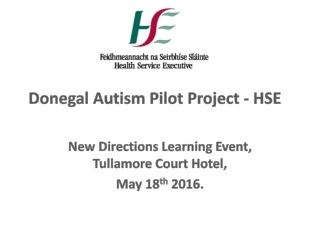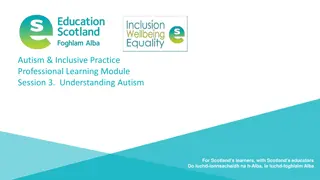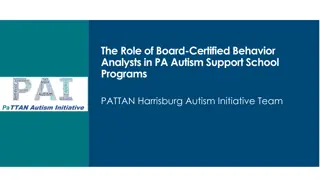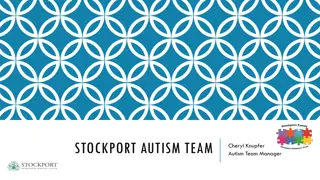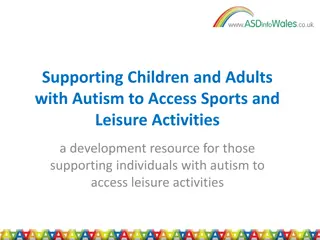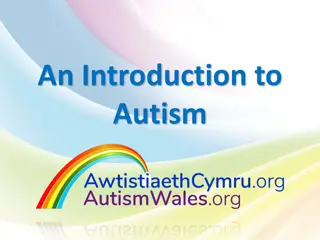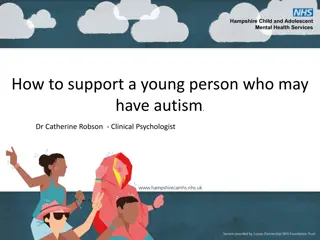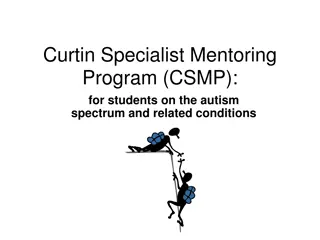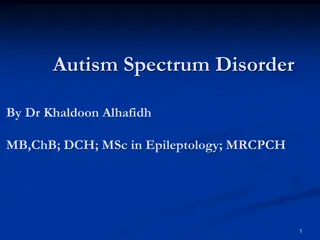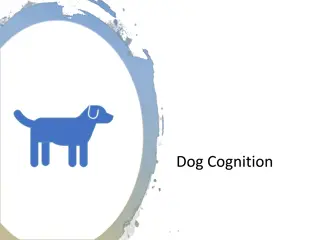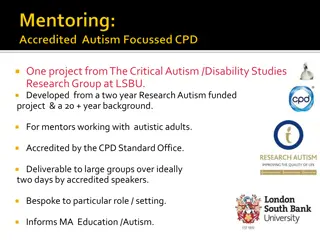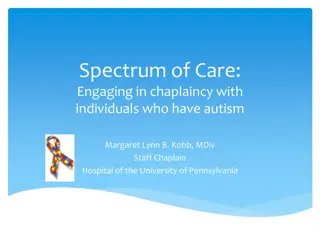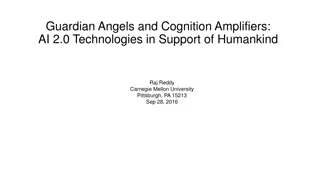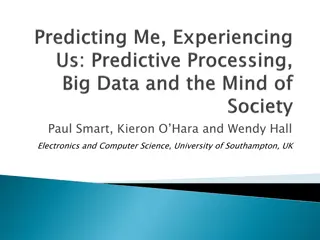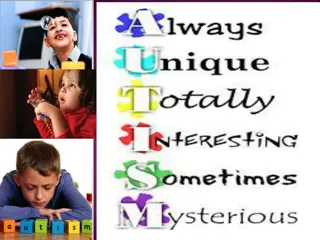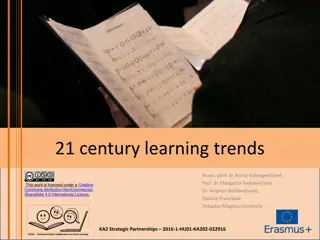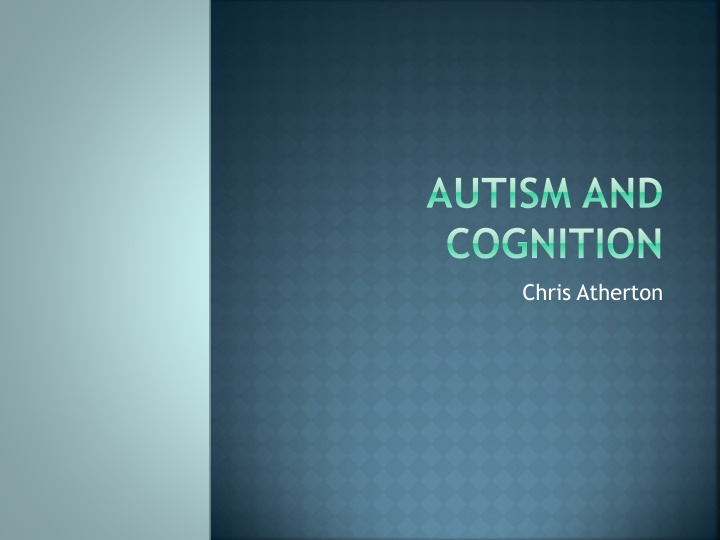
Understanding Autism: History, Prevalence, and Cognition Insights
Delve into the world of autism with insights on prevalence rates, cognition, causality, and the MMR vaccine controversy. Explore the history of autism through key figures like Bruno Bettelheim and Bernard Rimland, who played pivotal roles in shaping our understanding of this neurodevelopmental condition.
Download Presentation

Please find below an Image/Link to download the presentation.
The content on the website is provided AS IS for your information and personal use only. It may not be sold, licensed, or shared on other websites without obtaining consent from the author. If you encounter any issues during the download, it is possible that the publisher has removed the file from their server.
You are allowed to download the files provided on this website for personal or commercial use, subject to the condition that they are used lawfully. All files are the property of their respective owners.
The content on the website is provided AS IS for your information and personal use only. It may not be sold, licensed, or shared on other websites without obtaining consent from the author.
E N D
Presentation Transcript
AUTISM AND COGNITION Chris Atherton
AUTISM PREVALENCE New prevalence rates emerging 1/100 in United Kingdom National Autistic Society Five fold increase in the 1990s plateaued by early 2000s (Taylor et al., 2013) 1/68 in United States Centers (sic) for Disease Control March 2014 Lotter 1966 Presumed prevalence of 0.04%
THE AUTISM SPECTRUM Heterogenous Broadened considerably over time Geschwind and Levitt (2007) A collection of autisms that look similar at a superficial level. Happe Once you have met one person with autism... Focus on specific symptoms rather than syndromes (Happe, et al. 2006)
CAUSALITY 20% have rare genetic differences Siblings are at higher risk (Ozonoff et al., 2011)
NEURODIVERSITY Can be celebrated, but there is a reality to be mindful of: Howlin et al. (2013) 40 year follow up of 45 people with autism who s IQ was assessed as >70, 83% were not able to live independently
THE MMR Measles Mumps and Rubella Vacccine MMR was implicated by Andrew Wakefield in a 1998 medical journal called Lancet. This paper was retracted in 2010, judged to be flawed and fraudulent, and Wakefield was struck off the doctor s register after he was found guilty of professional misconduct and dishonesty. Many subsequent large scale studies have failed to link the MMR to autism. Vaccine rates struggle to reach pre-scare levels (The Psychologist, October 2014).
BRUNO BETTELHEIM Refrigerator Mothers
BERNARD RIMLAND Infantile Autism (1964)
BERNARD RIMLAND Infantile Autism (1964) Debunked the refrigerator mother hypothesis Identified autism as a cognitive dysfunction A single critical disability impaired ability to relate new stimuli to remembered experience Leads to inability to draw meaning from experience and to integrate sensations into a comprehensible whole Inspired a generation of research into autistic cognition. Rimland himself pursued possible links between autism and mercury poisoning through vaccination debunked.
WE TEND TO VIEW THINGS DIFFERENTLY Wendy Lawson
WEAK CENTRAL COHERENCE
THE WHOLE IS OTHER THAN THE SUM OF ITS PARTS Kurt Koffka, Father of Gestalt Psychology
CENTRAL COHERENCE Hermelin and O Connor (1970) what to went ship sea. what ship went to sea. Non autistic children made fewer errors if the words made up meaningful sentences. Recall was much better in non autistic children. Autistic children appeared to repeat the words without considering the meaning. Unaware of Rimland s book. Had a PhD student called Uta Frith...
FRITH AND SNOWLING (1983) Ten homographs He played lead guitar The box was made of lead. Children with autism found difficulty in ascribing meaning identified by consistent pronunciation regardless of whether the sentence suggested crying or ripping. Autistic children tended to say leed . The early sentence context had not been taken into account. (Replicated by Happe, 1997) Not an inability to extract meaning.
Subsequent proposal by Frith (1989) of weak central coherence focus on detail and failure to draw information together to extract meaning.
BLOCK DESIGN (WISC IV) Strong coherence can be a hindrance (Shah and Frith, 1993) Segmented versus un-segmented design Segmented Non autistic average 45s Un-segmented Non autistic average 95s Segmented Autistic average 45s Un-segmented Autistic average 65s Autistic group presented strength in their perceptual reasoning.
WHAT IS WEAK CENTRAL COHERENCE? Concerns the ability to pull information together, for higher level cohesion The inability to draw meaning as a whole . Attempt to describe a range of non-social features of autism by proposal of a single cognitive mechanism. Unusual cognitive strengths suggested by autistic behaviours: restricted interest, repetition, hypersensitivity, savant ability. Uta Frith s proposal: in an autistic brain, while the ability to discern a wide variety of things about the world is strong, the drive to make these various things cohere is weak.
CENTRAL COHERENCE Central coherence is descriptive Strength: Language and Communication Social Interaction Both are nuanced and contextually dependent Weakness: Not particularly testable / falsifiable Not part of mainstream cognitive psychology
PELLICANO AND BURR 2012 Bayesian Perspective The reduced influence of prior knowledge. Information is inherently unreliable and therefore needs to be used in the context of previous knowledge (a mathematical concept applied in statistics) Used increasingly in the context of perception sensory information is also ambiguous and inherently unreliable.
Experience determines likelihood This restricts the possibilities we consider Bayesian perspective proposes that autistic people have a broader categorisation of prior experience past experience therefore has a less restrictive influence on perception of the present.
MITCHELL ET AL., 2010 The curse of knowledge. Prior knowledge experience of rectangular shapes in a 3 dimensional world. People with autism were less susceptible to this effect.
Rimland Differences in information processing must come from differences in brain functioning Under-connectivity (Wass, 2011) Growing evidence for atypical brain connectivity in autism
PREDICTIVE CODING (FRISTON ET AL., 2013; VAN BOXTEL & LU, 2013) Main purpose of the nervous system is to anticipate what will happen next survival instinct. Minimising errors in this purpose is important we encode how precise our predictions are by comparing our expectations with actual outcomes.
PREDICTIVE CODING Two interpretations: Friston et al. (2013) Precision is reduced and therefore prediction is weaker, so perception is dominated by the information at hand. Van de Cruys et al. (2013) Precision is heightened in prediction errors small deviations from expectation becomes a significant error.
REVISED CONCEPTS OF WEAK CENTRAL COHERENCE Francesca Happe (1999) Proposed a normal distribution of preference or bias. Two extremes of a continuum: Detail focussed strategy Opposite preference Suggestion that typically, detail focus would be typical of the autism phenotype. Evidence that 50% of fathers, 30% of mothers of autistic children were stronger in detail focussed processing style. Not replicated in a sample of parents of dyslexic children. Briskman, Happe & Frith 2001; Happe, Briskman & Frith, 2001)
CENTRAL COHERENCE Part of the theory of autism Professor Francesca Happe Leo Kanner - Inability to experience wholes without full attention to constituent parts Distressed by tiny changes Difference in central coherence in ASD not a deficit. Differences found in non-autistic individuals.
(Alex in Williams, Sensory Issues in Autism, East Sussex) I DID NOT SEE WHOLE I SAW HAIR, I SAW EYES, NOSE, MOUTH, CHIN... NOT FACE
ACTIVITY Valuable Object
COGNITIVE THEORIES AND ASD Theory of Mind (Happ , 1994) Central Coherence (Frith, 1989, 1994) Executive Function (Hill, 2004) Extreme Male Brain (Baron-Cohen, 2003)
LORNA WING Once you have met one person with Autism, you have met one person with autism
WHAT IS THEORY OF MIND Not actually a theory ! Hugely significant feature of human cognition Develops by or around the age of 4. Ability to attribute mental states to others.
Uta Frith Professor of Cognitive Development London Mind-blindness Central Coherence
THEORY OF MIND - IMPORTANCE Recognition of thoughts and feelings Mentalising Frith Automatic ability to attribute mental states to yourself and other people. To recognise To communicate To influence Uniquely human?
SOCIAL ANIMALS (UTA FRITH) Hunt and flee in packs Choose mates Nurture young Recognise others Recognise emotions Recognise status Make alliances
SOCIAL HUMANS (FRITH) Teach Tease Trade Deceive Communicate ostensively e.g. about fear without being afraid Show complex emotions Manipulate beliefs Read others minds Read own mind Be self-conscious Explain and predict the behaviour of others
Development of social behaviours Development of cultural knowledge Development in understanding of others beliefs, intentions, desires
MENTAL REPRESENTATIONS Representations can be validated by reference to the world copies of the world Representations can be decoupled from the world to become attitudes to the world It is raining can be tested John believes it is raining cannot be validated by reference to the world (pointless to try and test this)
ALAN LESLIE (1987) Information processing analysis Mental states are propositional attitudes Agent Mother Sally Information Relation pretends believes Object this banana the marble Proposition is a telephone is in the basket
MENTAL REPRESENTATIONS Develop at around the age of two Representation of propositional attitudes must mark Agent: who has the mental state? Information Relation: what sort of attitude does the agent have? (belief, hope, pretend, dread) Not being able to understand that a person pretends had the same cause as not being able to understand that another person intends , knows , or believes . (Frith, 2012)
DECOUPLED REPRESENTATIONS John believes it is raining. Agent John Information relation belief about the world Why does this benefit us? Prediction John is going to take my umbrella!!!
Without reference to others psychological states, the behaviour of others becomes puzzling. Social impairment = Theory of Mind. False belief task paradigm was established The Sally Anne Test (Baron-Cohen, Leslie & Frith, 1985).
THEORY OF MIND - BRAIN What is the neurological basis? What if the neural connection was broken or faulty? What would that look like?
FALSE BELIEF TEST BARON-COHEN, LESLIE, FRITH (1985) Sally-Anne Test http://www.youtube.com/watch?v=qbk3H Q6heGk Children at age 5 will pass this easily Happe (1995) Meta-analysis of false belief tests looking at probability of passing. Autistic participants showed a 5 year delay, however almost all succeed on this task eventually. Considerable developmental delay.
SABTOAGE VS DECEPTION (SODIAN & FRITH 1992) Preventing harm from others Physical means Mental means

